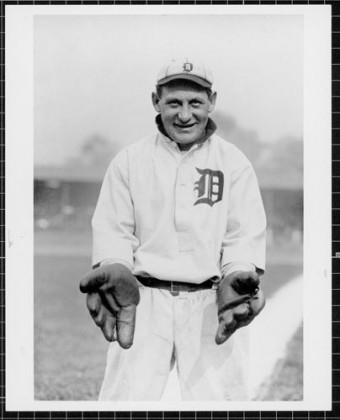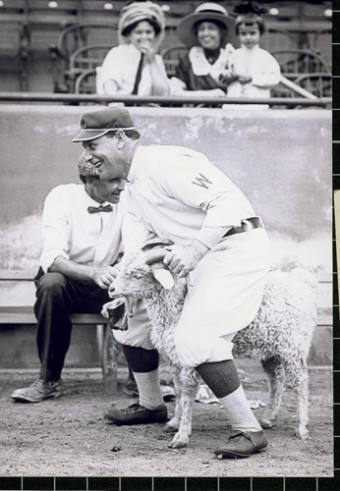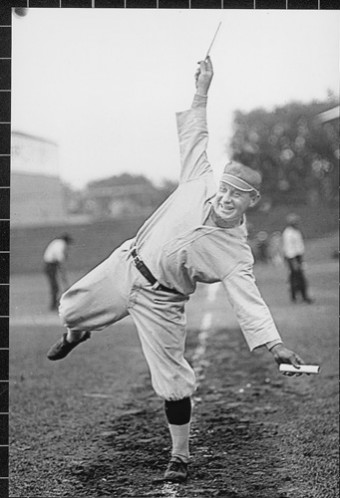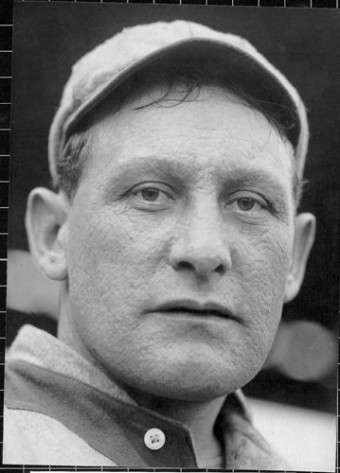There Once was a Major League Baseball Player Who Stole First From Second
 Today I found out there once was a MLB player who stole first from second.
Today I found out there once was a MLB player who stole first from second.
We’ve all seen the occasional child playing football accidentally run the wrong way on the field, and if you watch enough T-ball, you might even occasionally see a kid run the wrong way on the base paths. It turns out, there was once a Major League Baseball player who did this, only he did it on purpose.
The man was Herman “Germany” Schaefer, who also had other nicknames given to him such as “Dutch” and “The Prince”. Schaefer was a notorious prankster in baseball who would do things like wear rain coats or carry a lantern out onto the field during the game, trying to hint to the umpire that they should call the game because of rain or darkness (more of his zany antics in the Bonus Facts below).
One of his more memorable antics was to steal first base from second (possibly twice, though there is no documented proof of the first instance, just a story from a fellow player, Davy Jones.) Schaefer is the only known person to ever steal first in a Major League game and will remain so, because, probably due to Schaefer, a new rule was written shortly after his death at the age of 42 in 1919 from a “brain hemorrhage” and complications due to tuberculosis. Rule 52, Section 2, which is now Rule 7.08i:
After he has acquired legal possession of a base, [if] he runs the bases in reverse order for the purpose of confusing the defense or making a travesty of the game… [the] umpire shall immediately call “Time” and declare the runner out…
The supposed first instance of Schaefer stealing first, according to Davy Jones, occurred in a game against Cleveland around 1908, with the exact date unknown. With a runner on third late in the game, Schaefer stole second hoping to draw a throw from the catcher so that the runner on third, Davy Jones, could try and steal home. Jones gave the following account of what happened next in The Glory of Their Times, by Larry Ritter:
So now we had men on second and third. Well, on the next pitch Schaefer yelled, ‘Let’s try it again!’ And with a blood-curdling shout he took off like a wild Indian back to first base, and dove in headfirst in a cloud of dust. He figured the catcher might throw to first — since he evidently wouldn’t throw to second — and then I would come home same as before. But nothing happened. Nothing at all. Everybody just stood there and watched Schaefer, with their mouths open, not knowing what the devil was going on.
The umpires were just as confused as everybody else. However, it turned out that at that time there wasn’t any rule against a guy going from second back to first, if that’s the way he wanted to play baseball, so they had to let it stand. So there we were, back where we started, with Schaefer on first and me on third. And on the next pitch, darned if he didn’t let out another war whoop and take off again for second base. By this time the Cleveland catcher evidently had enough, because he finally threw to second to get Schaefer, and when he did I took off for home and both of us were safe.
 On August 4, 1911, Schaefer, playing for the Washington Senators, pulled the same stunt with less success, but at least this time documented in the newspapers. In this instance, it was the bottom of the ninth with a similar situation as above. There was a runner, Clyde Milan, on third who represented the winning run of the game (it was tied 0-0), and Schaefer on first. Schaefer broke for second and made it, but this failed to illicit a throw from White Sox catcher Fred Payne, as you might expect in the bottom of the ninth in a 0-0 tie where a runner on second is meaningless to the outcome of the game when there is already a runner on third. On the very next pitch Schaefer stole first, again without drawing a throw.
On August 4, 1911, Schaefer, playing for the Washington Senators, pulled the same stunt with less success, but at least this time documented in the newspapers. In this instance, it was the bottom of the ninth with a similar situation as above. There was a runner, Clyde Milan, on third who represented the winning run of the game (it was tied 0-0), and Schaefer on first. Schaefer broke for second and made it, but this failed to illicit a throw from White Sox catcher Fred Payne, as you might expect in the bottom of the ninth in a 0-0 tie where a runner on second is meaningless to the outcome of the game when there is already a runner on third. On the very next pitch Schaefer stole first, again without drawing a throw.
This brought the skipper of the White Sox, Hugh Duffy, out to argue with the umpires about allowing Schaefer to do this. While Duffy was still arguing with umpire Tommy Connolly, Schaefer broke for second, this time getting caught in a run-down, at which point Milan tried to steal home, but was thrown out ending the inning.
Not to be dissuaded, Schaefer argued with the umpire that this shouldn’t have counted because at the time of the play, the White Sox had ten team members on the field, though of course Hugh Duffy hadn’t played in a game since 1908. The umpires didn’t listen to his arguments and ruled that the play stood, as did his steal from second to first base because, at the time, there was no rule against it. The Senators went on to win the game 1-0 anyway.
If you liked this article and the Bonus Facts below, you might also like:
- There Once was a Little Person Who Played Major League Baseball
- Former Major League Baseball Player Moe Berg was a Secret Agent of the Predecessor to the CIA
- There Once was a MLB Player Traded for Himself
- Hall of Famer Richie Ashburn Once Struck a Spectator with Foul Balls Twice in the Same At Bat, the Second Time as She was Being Carried Off on a Stretcher
- There Once was a 17 Year Old Girl Who Struck Out Babe Ruth and Lou Gehrig Back to Back
- In High School, MLB Star Justin Verlander Traded a Small Percentage of His Eventual $3.12 Million Signing Bonus for a Chocolate Milk
Bonus Facts:
- Besides using raincoats to try to get games called because of rain, Schaefer was also known to occasionally wear galoshes and sometimes to also bring an umbrella out, on at least one instance even up to bat as if he was going to use it to bat. One of the instances where he wore a raincoat got him ejected from the game.
- Another antic that got him ejected once was wearing an extremely fake bushy black moustache up to bat. Generally, though, umpires gave Schaefer a lot of rope before they’d eject him, as reported in Sporting Life in 1912: “Schaefer is such a hit with the crowds that the umpires are giving him every liberty to do as he pleases.”
 After his playing career was over, as a coach now, Schaefer would commonly walk the coach’s box painted line as if it was a tightrope during the game to further entertain the crowd and attempt to distract the other team. He also would occasionally use bats as if they were oars and act as if he was rowing across the grass. He also once was thrown out of a game in Chicago by Umpire Silk O’Loughlin (June 8, 1912) for eating popcorn in the coach’s box during the game.
After his playing career was over, as a coach now, Schaefer would commonly walk the coach’s box painted line as if it was a tightrope during the game to further entertain the crowd and attempt to distract the other team. He also would occasionally use bats as if they were oars and act as if he was rowing across the grass. He also once was thrown out of a game in Chicago by Umpire Silk O’Loughlin (June 8, 1912) for eating popcorn in the coach’s box during the game.- The reason behind is antics? In a 1912 edition of Sporting News Schaefer stated, “Is humorous coaching of value to a team? I think so. It is valuable for two reasons. It keeps our fellows in good spirits, and it sometimes distracts the opposing players…I guess [Clark] Griffith thinks so also, for he encourages me in my tomfoolery.” Whether his antics were as a coach or a player, one fan noted that “Herman Schaefer… is one of the few ball players whose value to a team is not shown by statistics…” (and his career statistics weren’t great at a .257 career BA, .319 OBP, and .639 OPS). Despite this lack of being very good, writer Harry Salsinger once wrote of Schaefer, “As a drawing card, Herman ranks second only to Cobb…”
- After hitting a home run out of Columbia Park in Philadelphia, Schaefer chose to carry his bat around the bases with him acting as if it was a gun and that he was shooting the pitcher Rube Waddell with it.
- On June 24, 1906, Schaefer supposedly called his shot (again a story from Davy Jones, but at least this time it can be verified that Schaefer did hit the home run). With the Tigers down by one run with two outs in the ninth, Schaefer supposedly yelled “Ladies and gentlemen, you are now looking at Herman Schaefer, better known as ‘Herman the Great,’ acknowledged by one and all to be the greatest pinch-hitter in the world. I am now going to hit the ball into the left field bleachers. Thank you.” This was quite a claim from a player who at that point only had 2 home runs in his career. Schaefer then hit the first pitch off of Doc White into the left field bleachers. This is where his showmanship really kicked in. Rather than just trot around the bases, Schaefer made diving, headfirst slides into each base. This all was recorded in newspapers at the time. Davy Jones went on to say that after getting up from each base, Schaefer had called out his progress as if he was in a horse race, though few in the audience could hear him. “At the half, Schaefer leads by a length!… Schaefer leads by a mile!… Schaefer wins by a nose!” Jones said that after diving into home Schaefer stood up and called out, “Ladies and Gentlemen, this concludes this afternoon’s performance. I thank you for your kind attention.”
- This sort of thing wasn’t that rare for Schaefer, who liked to tell people he was psychic, and would often try to predict what was about to happen on the field. Most of the time, he was wrong, but, of course, as the late great Hall of Fame baseball announcer Dave Niehaus use to say “Nobody remembers those times, they only remember when you’re right”. A bit like when Mike Blowers called Matt Tuiasosopo’s first home run and the events around it in detail before the game even started between the Seattle Mariners and Toronto Blue Jays.
- Off the field, Schaefer was just as much of a joker as on, including one instance that got him later ejected from a game. Umpire Jack Sheridan once fell asleep at his table at a bar, which happened to be next to a drainpipe. When Schaefer saw this, he went upstairs to the top of the drain pipe and, using a spooky voice, moaned “Jack Sheridan, your time has come…” into the pipe repeatedly until Sheridan woke up and heard, running out of the bar in fright. The next game Schaefer was in where Sheridan was calling balls and strikes, Schaefer stepped up to the plate and said in the same creepy tone, “Jack Sheridan, your time has come…” Sheridan promptly threw Schaefer out of the game.
- Another common off-the-field antic of Schaefer, recalled by Ty Cobb, was Schaefer’s practice of holding running conversations with strangers on the street, while continuing to walk as he passed them and conversed, such that at the end of it, both he and the stranger would have to be screaming at the top of their lungs to hear each other from so far away. Trying to be polite, most people would continue on with the conversation until this happened. As Cobb stated, at the end “all street traffic would have stopped to listen open-mouthed to the dialogue and Germany never considered the stunt a complete success unless he still had the mother screeching answers when we were half a block away.”
- During one train trip, while on the vaudeville circuit with actress Grace Belmont in 1911, a fellow passenger in Schaefer’s compartment at night on the train yelled at Schaefer for keeping his lamp on while reading. Schaefer responded by turning off the lamp and then sneakily chucking what he thought were the passengers shoes out the window. In the morning, Schaefer realized he’d thrown his own shoes out.
- While many pranksters aren’t exactly well thought of by those who the pranks are pulled on, Schaefer was one of the exceptions. “Everybody loved the jovial, droll, pock-marked Chicago Dutchman,” according to sportswriter Fred Lieb. So much so that even Ty Cobb, who appeared to hate everyone, made an exception here, with Schaefer being one of his only friends. As sportswriter Malcolm Bingay said, “[Schaefer] was the soul of baseball itself, with all its sorrows and joys, the born troubadour of the game.”
- In 1913 as a member of an all-star team touring the world, Schaefer gave about a half hour speech to a crowd of 10,000 Japanese people who mostly didn’t speak English. As writer Malcolm Bingay said, “They had no more idea what he was saying than he did. But they cheered him wildly.”
 Schaefer’s pockmarked face was due to a smallpox epidemic that swept through Chicago when he was a boy. People who survived the ordeal tended to have badly pitted skin and Schaefer was no exception. Normally very jovial, this was one sore spot with Schaefer and he was known to become violent with people who made fun of his face, even with fans in the stadium where in semipro ball he frequently had to be pulled off such fans by teammates, according to a news account in 1898.
Schaefer’s pockmarked face was due to a smallpox epidemic that swept through Chicago when he was a boy. People who survived the ordeal tended to have badly pitted skin and Schaefer was no exception. Normally very jovial, this was one sore spot with Schaefer and he was known to become violent with people who made fun of his face, even with fans in the stadium where in semipro ball he frequently had to be pulled off such fans by teammates, according to a news account in 1898.- In October of 1914, Schaefer randomly showed up in Court to defend some homeless drunkards who were to be charged that day. His principle argument was that “these poor souls should not be sentenced to 30 days in jail for an offense that a millionaire would be sent home in a cab for.” The judge sided with Schaefer and let the drunkards go. Schaefer then took them all out to dinner.
- In a World Series game against the Cubs in 1907, while he was with the Tigers, Schaefer successfully pulled off the “hidden ball trick”, one of the few times this has been pulled in the post-season.
- Schaefer gave Walter Johnson the nickname “Barney” after being pulled over in a traffic stop and talking his way out of it by claiming that Walter Johnson, who was in the car, was racecar driver Barney Oldfield.
- Schaefer got his nickname “Germany” from the fact that his parents were German immigrants to the United States. He got the nickname “The Prince” due to his outlandish, flashy performances on the field, often written as “The Clown Prince of Baseball”.
- When WWI started, Schaefer attempted to change his nickname of “Germany” to “Liberty”, comedically referencing the fact that people had begun calling sauerkraut “liberty cabbage” (he was often called by hecklers a “sauerkraut-faced boob”). This is not unlike recently when certain Americans tried to call “French Fries” “Freedom Fries” after the backlash of the French not supporting the U.S. going to war with Iraq in 2003. Incidentally, you can read about the origin of French Fries here: The History of French Fries
- Schaefer is said to have been the inspiration for the MGM musical, Take Me Out to the Ball Game, staring Gene Kelly and Frank Sinatra.
- About what he’d do after retiring from baseball (which he never got the chance to do, because of his early death while still a scout), Schaefer once said in an interview he’d like to buy a saloon, “Not a big gaudy place, but a cozy spot where my friends can enjoy a glass of beer and a sociable evening. And along about 10 o’clock every evening I want one of my pals to say to the bartender on duty, ‘Where’s old Schaef tonight?’ And I want my bartender to be able to say, ‘He’s upstairs, drunk.'”
- Deadball Stars of the American League, by David Jones
- The Glory of Their Times, by Lawrence Ritter
- Germany Schaefer Stats
- Germany Schaefer
- Germany Schaefer
- MLB Feats That Have Only Happened Once
- Baseball History: Germany Schaefer
- Prankster Herman Schaefer
- Herman Schaefer Obituary
- Germany Schaefer
- White Sox Schedule, 1911
- Official Baseball Rulebook
- Freedom Fries
| Share the Knowledge! |
|





Not the only time this has happened. During the April 19, 2013, Brewers vs. Cubs game, Jean Segura ‘stole’ first base from second:
“Segura led off the eighth inning with a single and stole second before Braun walked. Segura attempted to steal third, but Shawn Camp didn’t deliver a pitch. Instead, he threw to third well ahead of Segura, who turned and went back to second.
“Braun was there, and shortstop Luis Valbuena tagged both runners as they stood on the bag.
“The rules say only the trailing runner is out in that case, but Segura trotted down the line toward first base and the home dugout, then appeared to realize what had happened and sped into the unoccupied base.”
There is some question about Germany Schaeffer’s steal of first in 1908. I was rereading Ritter’s Glory of Their Times and read Davy Jones’ account of the incident. I then read on Wikipedia that questioned Davy’s memory of the incident. Well, I thought I would do a little research. I did find an article in the old Brooklyn Daily Eagle. It was on page 26 of the February 9, 1947 edition of the paper. The headline, as written by Harold Burr, was “Here’s a Guy Who Once Stole First”. The story goes on to tell the story much like Davy Jones had it. The person recalling the play was the one and only Georgia Peach. He placed the location and time as being played at Cleveland some time before World War I.